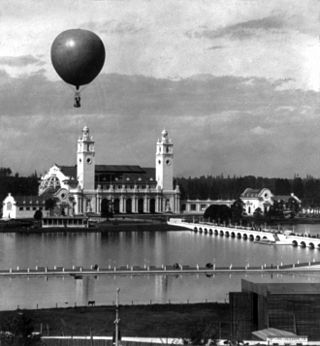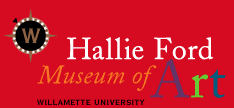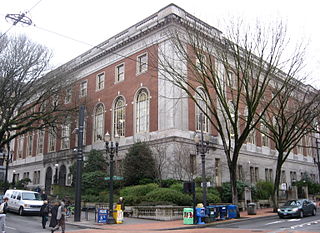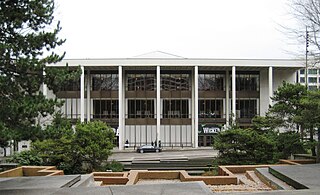
Portland is the most populous city in the U.S. state of Oregon, located in the Pacific Northwest region. Situated in the northwestern area of the state at the confluence of the Willamette and Columbia rivers, it is the county seat of Multnomah County, Oregon's most populous county. As of 2020, Portland's population was 652,503, making it the 26th-most populous city in the United States, the sixth-most populous on the West Coast, and the second-most populous in the Pacific Northwest, after Seattle. Approximately 2.5 million people live in the Portland metropolitan area, making it the 25th-most populous in the United States. About half of Oregon's population resides within the Portland metro area.
The Oregon Museum of Science and Industry is a science and technology museum in Portland, Oregon, United States. It contains three auditoriums, including a large-screen theatre, planetarium, and exhibition halls with a variety of hands-on permanent exhibits focused on natural sciences, industry, and technology. Transient exhibits span a wider range of disciplines.

Providence Park is an outdoor soccer venue located in the Goose Hollow neighborhood of Portland, Oregon. It has existed in rudimentary form since 1893, and as a complete stadium since 1926. Providence Park is currently the oldest facility to be configured as a soccer-specific stadium for use by a MLS team, and is one of the most historic grounds used by any United States professional soccer team.

The Oregon Historical Society(OHS) is an organization that encourages and promotes the study and understanding of the history of the Oregon Country, within the broader context of U.S. history. Incorporated in 1898, the Society collects, preserves, and makes available materials of historical character and interest, and collaborates with other groups and individuals with similar aims. The society operates the Oregon History Center that includes the Oregon Historical Society Museum in downtown Portland.

The Portland Art Museum (PAM) is an art museum in downtown Portland, Oregon, United States. The Portland Art Museum has 240,000 square feet, with more than 112,000 square feet of gallery space. The museum’s permanent collection has over 42,000 works of art. PAM features a center for Native American art, a center for Northwest art, a center for modern and contemporary art, permanent exhibitions of Asian art, and an outdoor public sculpture garden. The Northwest Film Center is also a component of Portland Art Museum.

The Lewis and Clark Centennial Exposition, commonly also known as the Lewis and Clark Exposition, and officially known as the Lewis and Clark Centennial and American Pacific Exposition and Oriental Fair, was a worldwide exposition held in Portland, Oregon, United States in 1905 to celebrate the centennial of the Lewis and Clark Expedition. While not officially considered a World's Fair by the Bureau of International Expositions, it is often informally described as such; the exposition attracted both exhibits and visitors from around the world. During the exposition's four-month run, it attracted over 1.6 million visitors, and featured exhibits from 21 countries. Portland grew from 161,000 to 270,000 residents between 1905 and 1910, a spurt that has been attributed to the exposition.

The Columbia River Maritime Museum is a museum of maritime history in the northwest United States, located about ten miles (16 km) southeast of the mouth of the Columbia River in Astoria, Oregon.

The history of the city of Portland, Oregon, began in 1843 when business partners William Overton and Asa Lovejoy filed to claim land on the west bank of the Willamette River in Oregon Country. In 1845 the name of Portland was chosen for this community by coin toss. February 8, 1851, the city was incorporated. Portland has continued to grow in size and population, with the 2010 census showing 583,776 residents in the city.

The High Desert Museum is located near Bend, Oregon, United States. Opened in 1982, it brings regional wildlife, culture, art and natural resources together to promote an understanding of natural and cultural heritage of North America's high desert country. The museum includes indoor and outdoor exhibits of wildlife in natural-like habitats along with traveling exhibits and living history demonstrations. The museum is accredited by the American Alliance of Museums. It is also a Smithsonian Affiliate institution.

Multnomah College, was a two-year, private college located in Portland in the U.S. state of Oregon. Established in 1897 as the Educational Department of the YMCA in downtown Portland, the school was the oldest fully accredited two-year college in the U.S. Pacific Northwest at the time it was absorbed by the University of Portland (UP) in 1969.

The Hallie Ford Museum of Art (HFMA) is the museum of Willamette University in Salem, Oregon, United States. It is the third largest art museum in Oregon. Opened in 1998, the facility is across the street from the Oregon State Capital in downtown Salem, on the western edge of the school campus. Hallie Ford exhibits collections of both art and historical artifacts with a focus on Oregon related pieces of art and artists in the 27,000 square feet (2,500 m2) facility. The museum also hosts various traveling exhibits in two of its six galleries.

Five Oaks Museum, formerly known as the Washington County Museum, is a history museum in Washington County, Oregon, United States. It is located at the Rock Creek campus of Portland Community College (PCC), north of Beaverton, Oregon. From 2012 to 2017, its public exhibit space was located in downtown Hillsboro, Oregon, before it was moved back to PCC, its pre-2012 location and where the museum's research facility had already been located.

The Sovereign Hotel was a Portland, Oregon, hotel built in 1923. The nine-story building was added to the United States' National Register of Historic Places on December 2, 1981. Part of the building houses a portion of the Oregon Historical Society's Oregon History Center.

The Museum of Science & History - Pink Palace in Memphis, Tennessee, serves as the Mid-South's major science and historical museum and features exhibits ranging from archeology to chemistry. Over 240,000 people visit the museum each year.

The Central Library is a three-story public library branch in the downtown core of Portland, Oregon, United States. Opened in 1913, it serves as the main branch of the Multnomah County Library system. In 1979, the Georgian style building was added to the National Register of Historic Places as the Central Building, Public Library. The library underwent major structural and interior renovations in the mid 1990s. The library also underwent a refresh in 2023.

Keller Auditorium, formerly known as the Portland Municipal Auditorium, the Portland Public Auditorium, and the Portland Civic Auditorium, is a performing arts center located on Clay Street in downtown Portland, Oregon, United States. It is part of the Portland's Centers for the Arts. Opened in 1917, the venue first changed names in 1966, being renamed again in 2000 in honor of a $1.5 million renovation donation by Richard B. Keller. An extensive remodeling and modernization in 1967–68 effectively changed its original exterior appearance beyond recognition.
Bill Papas's mural of Portland, Oregon depicts more than 50 prominent residents of the city during the 1990s. The watercolor painting was displayed at a restaurant in the Hilton Portland Hotel from 1995 to 2014. It was donated to the Oregon Historical Society when the hotel and restaurant were redesigned. The Oregon Historical Society Museum exhibited the work in early 2015, and again for one month in 2018. People depicted in the mural include Stephen Bollenbach, Gert Boyle, James DePreist, Sho Dozono, Jack Faust, Peggy Fowler, Neil Goldschmidt, Mark Hatfield, Barron Hilton, Vera Katz, John Kitzhaber, Phil Knight, Robert B. Pamplin, Arlene Schnitzer, Fred Stickel, and Charles Swindells.

The Republic Cafe and Ming Lounge are a Chinese restaurant and bar in Portland, Oregon's Old Town Chinatown, in the United States. The restaurant is one of Portland's oldest, established in 1922, and continues to operate under the Mui family's ownership. Serving Chinese cuisine such as Mongolian beef, General Tso's chicken, chop suey, and egg foo young, the Republic Cafe has been described as a "staple" of the neighborhood and the city's Chinese American history. Celebrities have visited the restaurant which has also seen several longtime employees. Ming Lounge is among the city's oldest bars and has been characterized as "seedy".

Back Stage Bar is a bar and restaurant operated by McMenamins in Portland, Oregon.



















